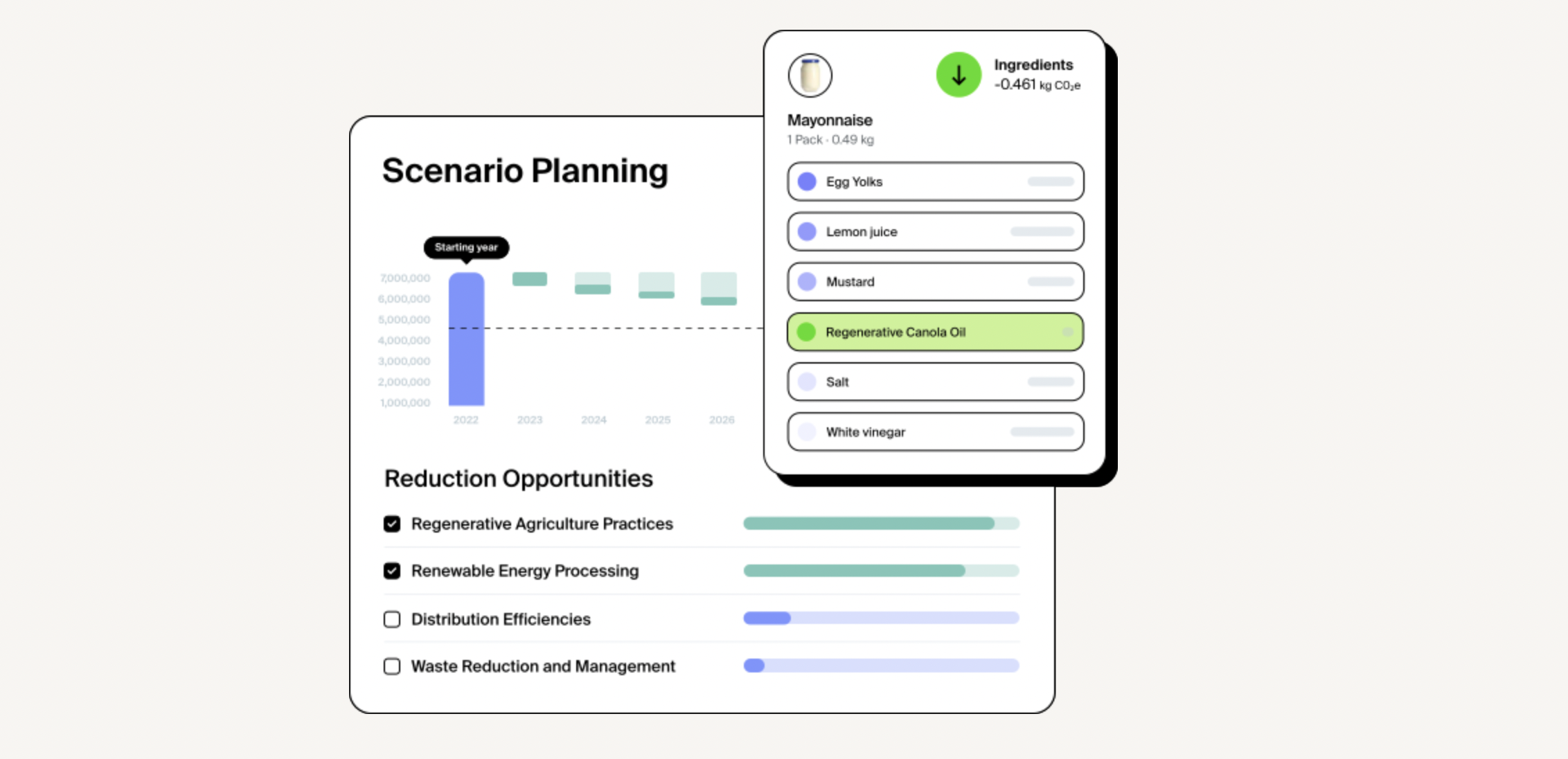Inside Planet FWD’s Climate Methodology
How Planet FWD builds the deepest database in the Food & Beverage Industry

In a world increasingly focused on sustainability, the food and beverage industry faces significant challenges in reducing its environmental footprint. Fortunately, innovative approaches are emerging to address these challenges head-on. Planet FWD’s platform guides food & beverage companies of all sizes as they take action to reduce their climate impacts.
The backbone of our platform is an industry-leading, proprietary database of agricultural ingredients and materials and a dedicated team of scientists and engineers from diverse scientific backgrounds. This database has been developed for more than 15 years and continues to grow.
A Multidisciplinary Team with Deep Industry Expertise
Our database's strength lies in the diverse expertise of our team, which includes experts in environmental engineering, agricultural science, process engineering, environmental science, food science, and chemical engineering. With extensive industry experience and specialties ranging from materials sustainability to renewable energy, our team brings a wealth of knowledge to the table.
Our scientists leverage this collective expertise to develop ingredient models, drawing from various sources such as primary data, peer-reviewed literature, government and NGO publications, production patents, and product manufacturing guides. This rich tapestry of information is complemented by our team's real-world industry experience, from on-farm research experience and food scientists to experience working at the world’s leading resource for climate solutions, Project Drawdown.
This combination of experience ensures that our models accurately represent complex production systems.
Rigorous Methodology and Data Validation
All of the data in our database undergoes a meticulous validation and verification process to meet our stringent data quality standards. Our ingredient models are built using methodologies aligned with the Greenhouse Gas Protocol, as well as IPCC methodologies, guaranteeing the reliability of our data.
Continuous improvement is at the heart of our mission. Our database is a living entity, constantly updated and expanded to include more ingredients and improve existing models whenever more robust data becomes available.
What Sets Our Database Apart
Our database boasts an extensive collection of cradle-to-farmgate models for agricultural products, covering nearly all common products used in the consumer packaged goods (CPG) and foodservice sectors. These agricultural models form the foundation for our processed ingredient models, which span from cradle-to-production gate.
The processed ingredients in our database range from minimally processed items like flour and roasted nuts to some of the most highly processed and complex ingredients utilized in the food industry, such as protein isolates and refined oils. But our scope doesn't stop at food and beverages; we also include data on packaging materials, chemicals, cleaning agents, and more.
Unlike many other sources that offer limited variety for each ingredient, our database incorporates variations based on a variety of factors like region, farming practices, and processing methods, providing a comprehensive view of the environmental impacts associated with the ingredients.
Pioneering Novel Ingredient Models
What truly sets us apart is our commitment to innovation. Our team's industry knowledge and expertise empower us to create models for novel ingredients that are often absent from other databases and LCA literature. For instance, we delve into the environmental impact of functional ingredients like:
- Enzymes
- Preservatives
- Anti-caking agents
- Stabilizers
- Leavening agents
- Fat replacers, and
- Acidulants
While some LCAs might overlook these ingredients due to their negligible mass contribution, we recognize their significance in terms of energy-intensive production processes and their potential to impact a product's total emissions. This allows you to receive a much fuller picture of your emissions and environmental impact, giving you a 360-degree view of your product footprint.
Flexible Lifecycle Stage Modeling
One of our key strengths is the ability to model each lifecycle stage as an inflow into the next. Supply chains are complex and interwoven. The versatility of our models allows us to conduct assessments at any stage, catering to the specific needs of our customers. Whether it's cradle-to-farmgate for agricultural producers or cradle-to-processing gate for ingredient producers, our database provides the granularity needed to pinpoint emissions contributions accurately.
Provider-Specific or General Results
Our vast database, coupled with our flexible modeling tools, enables us to create bespoke models at various levels of specificity across all lifecycle stages.
We can:
- Construct entirely custom models based solely on primary data provided by our customers, going as specific as farm-level details.
- Integrate primary data into pre-existing models when customers have limited data.
- Utilize ingredient specifications to identify the best match in our database when primary data is scarce.
So you can:
- Rely on our team’s industry knowledge and experience to make informed assumptions when primary data is extremely limited or unavailable.
- Get the most in-depth understanding of your supply chain-related emissions based on the best available information you have.
- Feel secure in the high-fidelity of your supply chain data to drive informed decisions.
In the ever-evolving landscape of sustainability within the food and beverage industry, data-driven decision-making is paramount. Our team's expertise and our comprehensive database empower businesses to make informed choices and understand feasible opportunities to reduce their environmental footprint. With novel ingredient models, high coverage of data for the food industry, and flexible modeling capabilities, we stand at the forefront of sustainability solutions, ready to support businesses in their climate action journey.
Head of marketing
Lorem ipsum dolor sit amet, consectetur adipiscing elit. Consectetur, adipiscing elit, sed do eiusmod tempor incididunt ut lab. Lorem ipsum dolor sit amet, consectetur adipiscing elit. Lorem ipsum dolor sit amet, consectetur adipiscing elit.
This is an example blog post style
Lorem ipsum dolor sit amet, consectetur adipiscing elit, sed do eiusmod tempor incididunt ut labore et dolore magna aliqua. Sed vulputate odio ut enim. Volutpat sed cras ornare arcu dui. Lorem dolor sed viverra ipsum. Luctus accumsan tortor posuere ac ut consequat semper. Viverra justo nec ultrices dui sapien eget mi proin. Mollis nunc sed id semper risus in hendrerit gravida rutrum. Lacinia quis vel eros donec. Nisi vitae suscipit tellus mauris a diam. Ac orci phasellus egestas tellus rutrum tellus pellentesque eu tincidunt. Morbi quis commodo odio aenean sed adipiscing diam. Urna duis convallis convallis tellus id interdum. Tortor vitae purus faucibus ornare suspendisse sed. Vehicula ipsum a arcu cursus vitae congue. Enim sed faucibus turpis in. Orci eu lobortis elementum nibh tellus molestie nunc non blandit.
Nunc id cursus metus aliquam eleifend mi in. A erat nam at lectus urna duis convallis convallis. Tristique senectus et netus et malesuada fames ac. Id interdum velit laoreet id donec. Egestas dui id ornare arcu odio. Gravida rutrum quisque non tellus orci ac auctor. Malesuada fames ac turpis egestas maecenas pharetra convallis. Ut diam quam nulla porttitor. Eget nunc lobortis mattis aliquam faucibus purus. Aenean sed adipiscing diam donec adipiscing tristique risus nec. Nisi est sit amet facilisis magna etiam tempor orci eu. Tortor posuere ac ut consequat.
“Lorem ipsum dolor sit amet, consectetur adipiscing elit”
<span class="blockquote-wrap">
<strong>Naomi</strong>
Head of marketing
</span>

This is an example blog post style
Lorem ipsum dolor sit amet, consectetur adipiscing elit, sed do eiusmod tempor incididunt ut labore et dolore magna aliqua. Sed vulputate odio ut enim. Volutpat sed cras ornare arcu dui. Lorem dolor sed viverra ipsum. Luctus accumsan tortor posuere ac ut consequat semper. Viverra justo nec ultrices dui sapien eget mi proin. Mollis nunc sed id semper risus in hendrerit gravida rutrum. Lacinia quis vel eros donec. Nisi vitae suscipit tellus mauris a diam. Ac orci phasellus egestas tellus rutrum tellus pellentesque eu tincidunt. Morbi quis commodo odio aenean sed adipiscing diam. Urna duis convallis convallis tellus id interdum. Tortor vitae purus faucibus ornare suspendisse sed. Vehicula ipsum a arcu cursus vitae congue. Enim sed faucibus turpis in. Orci eu lobortis elementum nibh tellus molestie nunc non blandit.
<span class="rtb-protip">
<span class="rtb-protip-title"></span>
<span class="rtb-protip-body">Lorem ipsum dolor sit amet, consectetur adipiscing elit, sed do eiusmod tempor incididunt ut labore et dolore magna aliqua. Ut enim ad minim.</span></span>
How to customize formatting for each rich text
- Lorem ipsum dolor sit amet, consectetur adipiscing elit sed do eiusmod
- Lorem ipsum dolor sit amet, consectetur adipiscing elit sed do eiusmod
- Lorem ipsum dolor sit amet, consectetur adipiscing elit sed do eiusmod
- Lorem ipsum dolor sit amet, consectetur adipiscing elit sed do eiusmod
Headings, paragraphs, blockquotes, figures, images, and figure captions can all be styled after a class is added to the rich text element using the "When inside of" nested selector system.
Static and dynamic content editing
A rich text element can be used with static or dynamic content. For static content, just drop it into any page and begin editing. For dynamic content, add a rich text field to any collection and then connect a rich text element to that field in the settings panel. Voila!
- Lorem ipsum dolor sit amet, consectetur adipiscing elit sed do eiusmod
- For static content, just drop it into any page and begin editing. For static content, just drop it into any page and begin editing.
- Lorem ipsum dolor sit amet, consectetur adipiscing
How to customize formatting for each heading
Headings, paragraphs, blockquotes, figures, images, and figure captions can all be styled after a class is added to the rich text element using the "When inside of" nested selector system.



